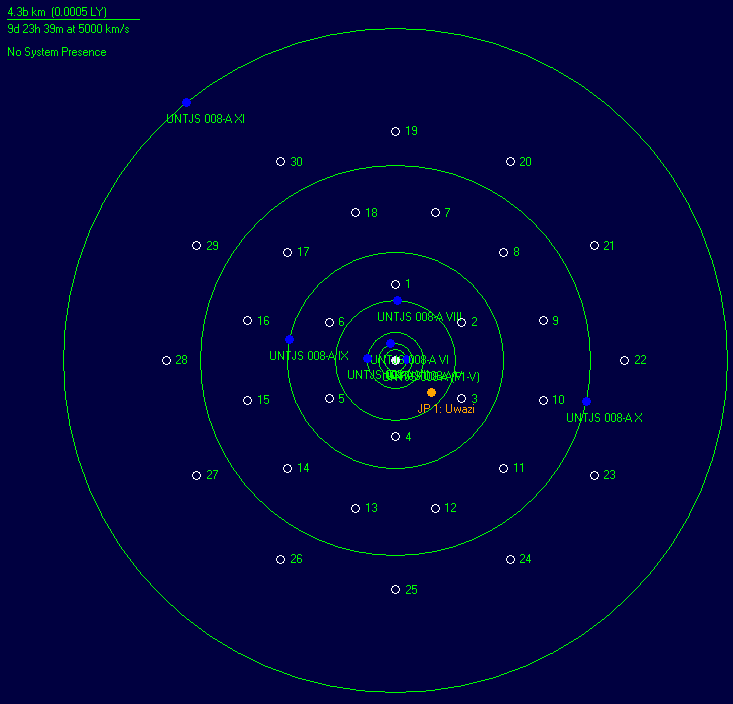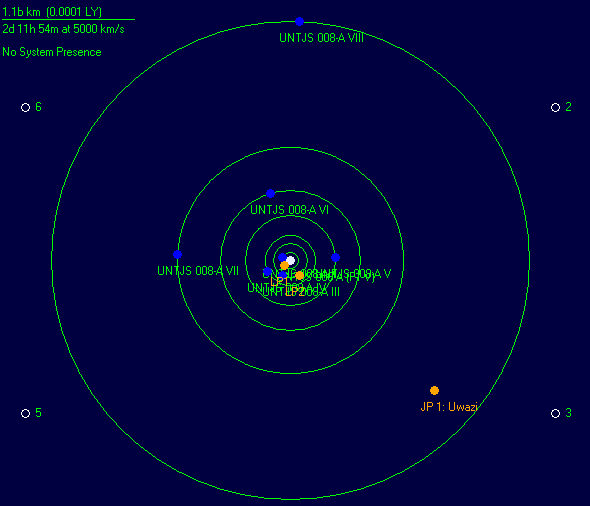Batavia
| This article is a stub. You can help the wiki by expanding it. |
Link to Systembodies Raw Viwer
Right Ascension: 20h28'48"
Declination: Declination 49°24'36"
Distance: 241.6 parsecs (788 light years)
Batavia, originally designated UNTJS 008, is a UN-claimed system connected to the Uwazi crossroads. It consists of numerous gas giants and their moons and, most notably, includes an Earh-like planet in the habitable zone. The planet, with an nitrogen-oxygen atmosphere and almost comfortable temperatures, is one of the top colonization prospects in the known universe.
An incident occurred slightly after the system's discovery in which the UN scout ship UNS Eratosthenes was destroyed near orbit of the Earth-like planet. Since Eratosthenes was equipped by sensitive passive sensors and haven't reported any thermal or EM signatures, the planet is likely an unpopulated world with automated defense systems.

Geography
Batavia consists of a single star and its attendant planetary system. The star is an F1-V, a bright white main sequence star, 50% larger than the sun in diameter and mass and over four times more luminous. Based on stellar spectroscopy and modeled planetary dynamics, the system is estimated at being roughly one billion years old. The emergence jump point from Uwazi is unstabilized, sitting at a distance of 1.58 billion km from the primary at a bearing of 132°. The system is located at Right Ascension 20h28'48", Declination 49°24'36", 241.6 pc from Earth in the direction of the constellation Cygnus.
The planetary system of Batavia consists of seven gas or ice giants, three large terrestrial planets, and a single dwarf planet. There are no major asteroid belts or comets of note, perhaps because of the area-clearing properties of the large number of gas giants in the system. Extending from 35m km out to 10.8b km, the system is about twice the size of Sol out to Pluto.
- The innermost planet (Batavia-A I) is a Neptunian world 13 times more massive than Earth, with a diameter approximately 3.5 times that of Earth. The planet orbits at a scant 35m km from the primary (about the orbital distance of Mercury), which has served to remove any moon system it may have had.
- Batavia-A II is a massive super-Jovian, 6.2 times more massive than Jupiter. This huge mass means that it has created an intrasystem jump point at its trailing Lagrange point. Unfortunately, the only other body large enough to create an L-point is A III, for a maximum travel savings of only 205m km. Like Batavia-A I, A II orbits so closely that gravitational perturbations from the primary have removed any moon system that may have once existed.
- Batavia-A III is a large Jovian planet, 40% more massive than Jupiter. With a semi-major axis of 137m km, the planet is far enough from the primary that it has maintained its moon system, with twelve bodies over 30 km in radius. Two of these moons (Moon 2 and Moon 3, orbiting at 300k and 600k km, respecitvely) have enough surface gravity to support long-term human habitation, but temperatures over 100°C restrict likely colonization efforts. WAYFARER could not obtain good imagery of Moon 2, but Moon 3 is a Luna-like world, heavily cratered and lacking an atmosphere.
- The next planet, Batavia-A IV, is an astronomical curiosity. Orbiting at 207m km from the primary, it is an ice giant less than four times more massive than Earth, with a radius only three times greater than Earth's. This so-called sub-Neptunian world may represent the utter minimum size of a body whose mass consists mostly of gas. It has fifteen moons larger than 20 km in radius. Moon 7 and Moon 9 have gravities which lend themselves to human habitation. Surface temperatures on these bodies range between 30°C and 50°C, but like most other moons in the system, they have no atmospheres, making colonization an uncertain prospect at best.
- Batavia-A V is an extremely exciting world. A near clone of Earth, the body is 2% larger in diameter and mass than Earth, with a surface gravity of 0.88g, orbiting at 366m km. Perhaps more importantly, spectroscopy of its atmosphere reveals a composition very similar to Earth, consisting of 88% nitrogen and 12% oxygen (with an oxygen partial pressure of 0.09 atm). With surface temperatures averaging about -18°, only moderate warm weather clothing would be necessary on the surface, as well as a supplemental oxygen mask. Spectroscopy also reveals the presence of copious quantities of liquid water on the surface, with some estimates indicating that liquid oceans cover up to 79% of the surface.
- A V has a day that is 4d 3h long in Earth units, while its year is over 3 Earth years long.
- A V possesses two airless moons, both tidally locked. The innermost moon is a small world 400 km in diameter, which orbits every 2d 7h. The outer moon is a quarter the diameter of Earth, and has enough surface gravity to support human habitation. It orbits once every 9d 6h.
- The addition of a mere 0.01 atm of oxygen to the atmosphere of this world would drop its colonization cost factor to 30 units of infrastructure per million inhabitants, most of this going into heating elements for shelter construction. The average temperature of the planet needs to be raised by only 8.3° in order to fit within the comfortable tolerances of humanity. These factors combine to make this world the most human-friendly world other than Earth yet discovered.
- The next planet, Batavia-A VI, is a rocky desert world with a frozen CO2/Nitrogen atmosphere of 0.07 atm. Spectroscopy reveals the presence of large water ice sheets covering nearly half the planet. A small ring system is also present. With 80% of the diameter or Earth and 30% the mass, A VI has a surface gravity of 0.479g. An orbital distance of over 564m km mean that average surface temperatures are well under -50°C, and the lack of oxygen in the atmosphere makes it an unlikely target for colonization.
- Batavia A-VII is largely similar to A VI in size and mass, with a surface gravity of 0.472g. However orbiting nearly twice as far out (918m km), the planet is much colder, with average temperatures below -131°C. It possesses a thin hydrogen/helium/nitrogen atmosphere with a total pressure of 0.22 atm. The combination of frigid temperatures and unsuitable atmosphere make this planet unlikely to be considered for permanent human habitation.
- Batavia-A VIII orbits nearly 2 billion km from the primary. It is a small gas giant, about 1/7th the mass of Jupiter. It is interesting in that, like Uranus, it has a significant axial tilt, in this case 78°. Thus it experiences extreme seasons, leaving some portions in shadow for long stretches of its nearly 39 year period of revolution. The planet has 15 moons larger than 20 km in radius, two of which (4 and 14) have sufficient surface gravity to support human habitation. Moon 14 is an astmosphereless ice world, but Moon 4 appears to be a rocky body with a nitrogen/methane atmosphere and, perhaps surprisingly for a natural satellite, a ring system of its own, orbiting 329000 km from A VIII once every 3d 8h.
- Batavia-A IX is a dwarf planet with a radius of 1200 km. Likely consisting entirely of ice, the body does not have enough surface gravity for long-term human settlement.
- Batavia-A X is another small Jovian, 1/8th the mass of Jupiter, with 16 moons over 20km in radius. Two of the moons (3 and 16) are large enough to support human habitation, though the frigid temperatures 6.3b km from the primary mean that their colonization costs are prohibitive. Neither has an atmosphere, though the #3 moon is a body nearly a third the size of Earth. Its icy composition, however, means that it is only 3% as massive as Earth, for a surface gravity of 0.225g.
- The outermost planet, Batavia-A XI, is a medium Jovian orbiting nearly 72 AU from the primary. It has nearly half the mass of Jupiter and at least 17 moons greater than 20km in radius. Moons 3 and 6 are large enough to have surface gravity greater than 0.1g. Moon 6 is an icy body with nearly half the diameter of Earth but only 3% the mass, giving it a surface gravity of 0.103g. Temperatures out here are less than 50 K above absolute zero, making neither of these technically-inhabitable moons inviting colonization prospects.
System Schematics
Fig. 1: UNTJS 008 System Overview.
Fig. 2: UNTJS 008 System Detail.
Fig. 3: UNTJS 008 Inner System. Note extensive moon system of A III.


